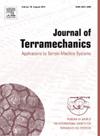Machine learning-based estimation of agricultural tyre sinkage: A streamlit web application
IF 3.7
3区 工程技术
Q3 ENGINEERING, ENVIRONMENTAL
引用次数: 0
Abstract
This study investigates the impact of wheel slip, drawbar pull, and soil strength on agricultural tyre sinkage under varying normal loads and inflation pressures. A controlled experiment was conducted with a 13.6–28 bias ply tyre using single wheel tester in a soil bin, measuring tyre sinkage, drawbar pull, and wheel slip across different conditions. Machine learning models, including Artificial Neural Network (ANN) and Support Vector Regression (SVR), were developed to predict tyre sinkage based on key variables, with hyperparameter tuning to optimize model performance. The SVR model outperformed the ANN model, with Coefficient of determination (R2) and Mean Squared Errors (MSE) as 0.997 and 0.8 for training; 0.981 and 4.3 mm for testing, respectively. The Mean Absolute Error (MAE) and Mean Absolute Percentage Error (MAPE) were also significantly lower for SVR, with MAPE values of 2.58 % (training) and 6.94 % (testing). The optimized SVR model was integrated into a Streamlit web application, offering a user-friendly platform for real-time predictions of tyre sinkage. This application had significant potential for enhancing tractive efficiency and minimizing soil degradation in agricultural practices. The study highlighted the efficacy of machine learning techniques in modelling tyre sinkage.
基于机器学习的农用轮胎下沉估计:一个流光web应用
本文研究了在不同的正常载荷和充气压力下,轮滑、拉杆拉力和土壤强度对农用轮胎下沉的影响。以13.6-28斜交轮胎为试验对象,采用土仓式单轮测定仪对不同工况下的轮胎下沉、牵引力和车轮打滑进行了对照试验。利用人工神经网络(ANN)和支持向量回归(SVR)等机器学习模型,基于关键变量预测轮胎下沉,并通过超参数调整优化模型性能。SVR模型优于ANN模型,训练的决定系数(R2)和均方误差(MSE)分别为0.997和0.8;分别为0.981和4.3 mm。平均绝对误差(MAE)和平均绝对百分比误差(MAPE)的SVR值也显著降低,MAPE值为2.58%(训练)和6.94%(测试)。将优化后的SVR模型集成到Streamlit web应用程序中,为轮胎下沉的实时预测提供了一个用户友好的平台。在农业实践中,该应用具有显著的提高牵引效率和减少土壤退化的潜力。该研究强调了机器学习技术在模拟轮胎下沉方面的功效。
本文章由计算机程序翻译,如有差异,请以英文原文为准。
求助全文
约1分钟内获得全文
求助全文
来源期刊

Journal of Terramechanics
工程技术-工程:环境
CiteScore
5.90
自引率
8.30%
发文量
33
审稿时长
15.3 weeks
期刊介绍:
The Journal of Terramechanics is primarily devoted to scientific articles concerned with research, design, and equipment utilization in the field of terramechanics.
The Journal of Terramechanics is the leading international journal serving the multidisciplinary global off-road vehicle and soil working machinery industries, and related user community, governmental agencies and universities.
The Journal of Terramechanics provides a forum for those involved in research, development, design, innovation, testing, application and utilization of off-road vehicles and soil working machinery, and their sub-systems and components. The Journal presents a cross-section of technical papers, reviews, comments and discussions, and serves as a medium for recording recent progress in the field.
 求助内容:
求助内容: 应助结果提醒方式:
应助结果提醒方式:


